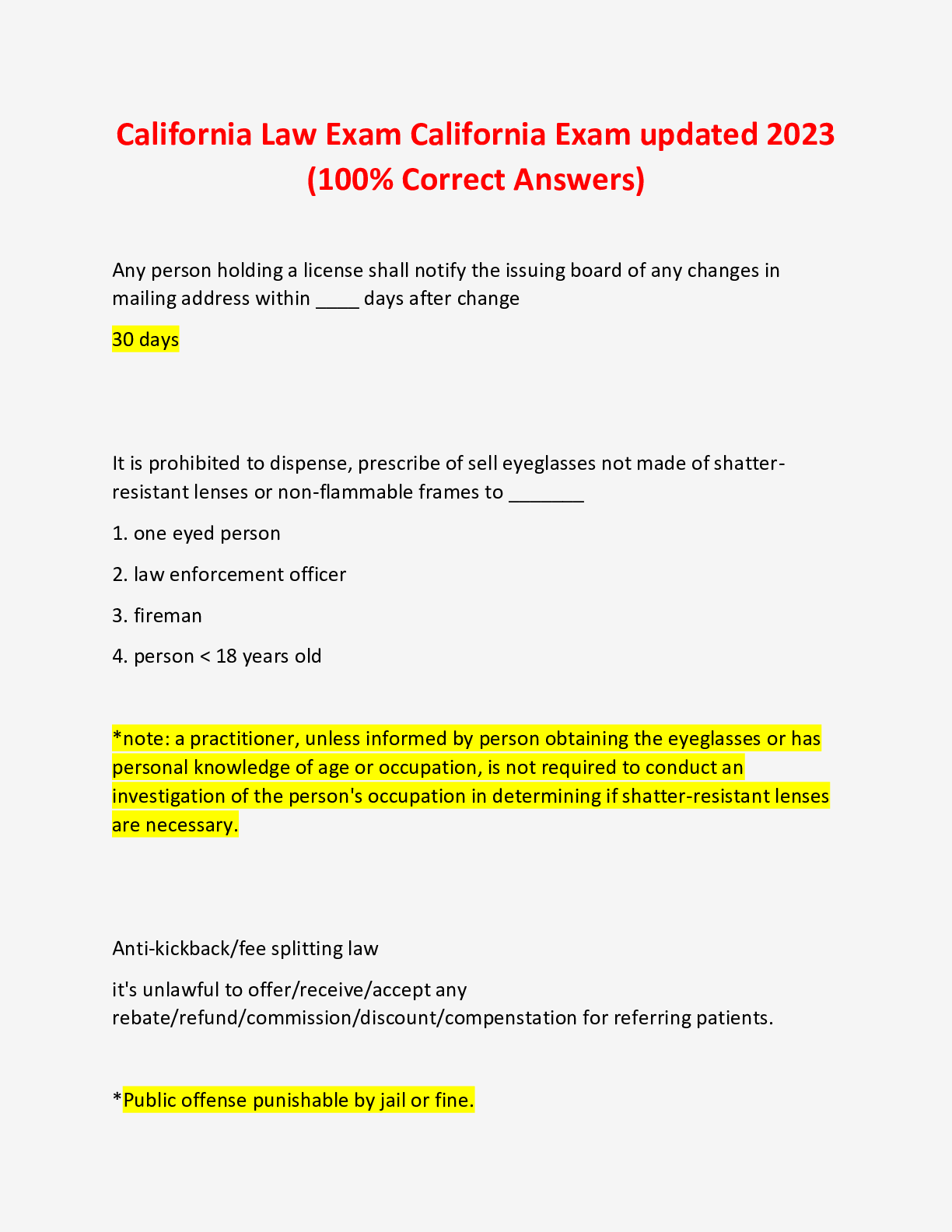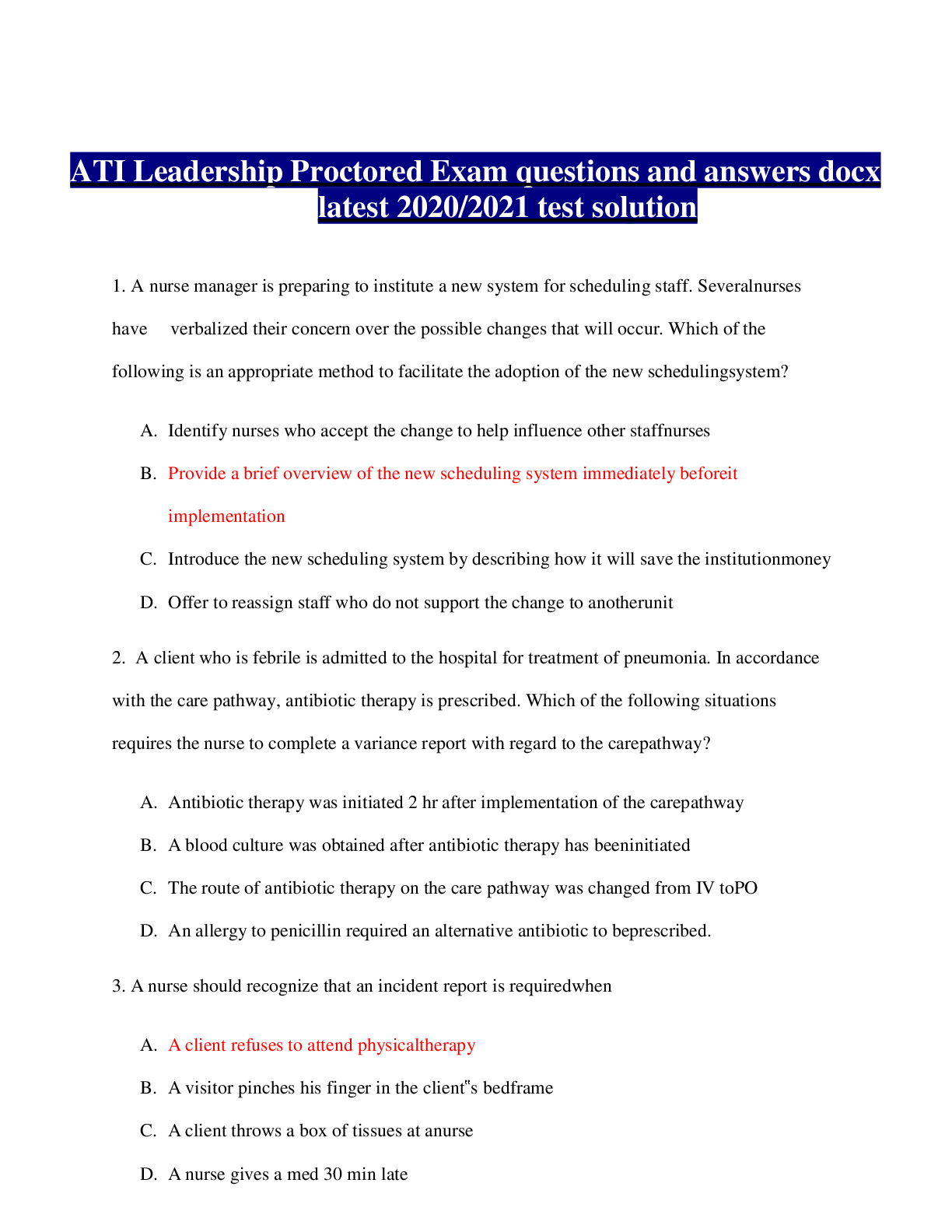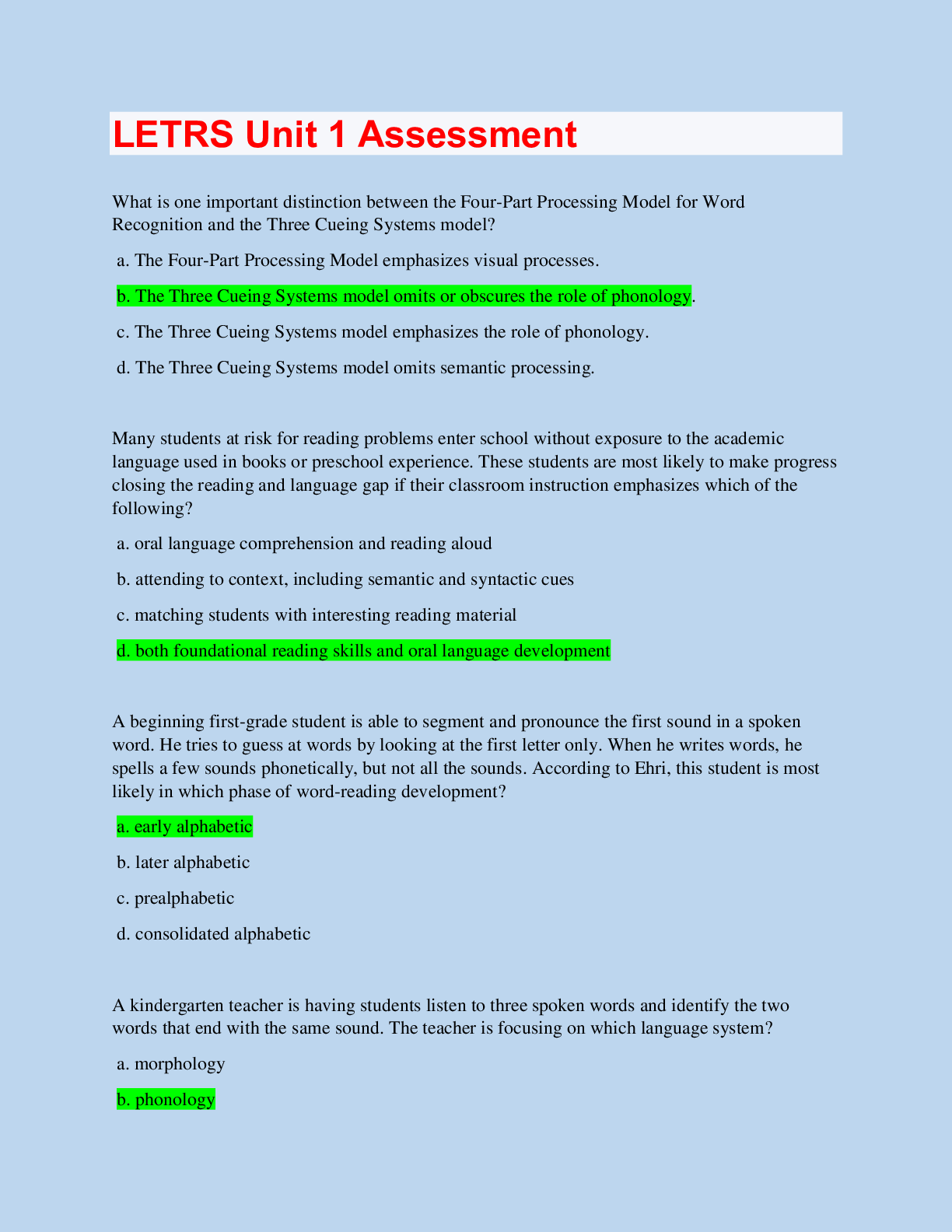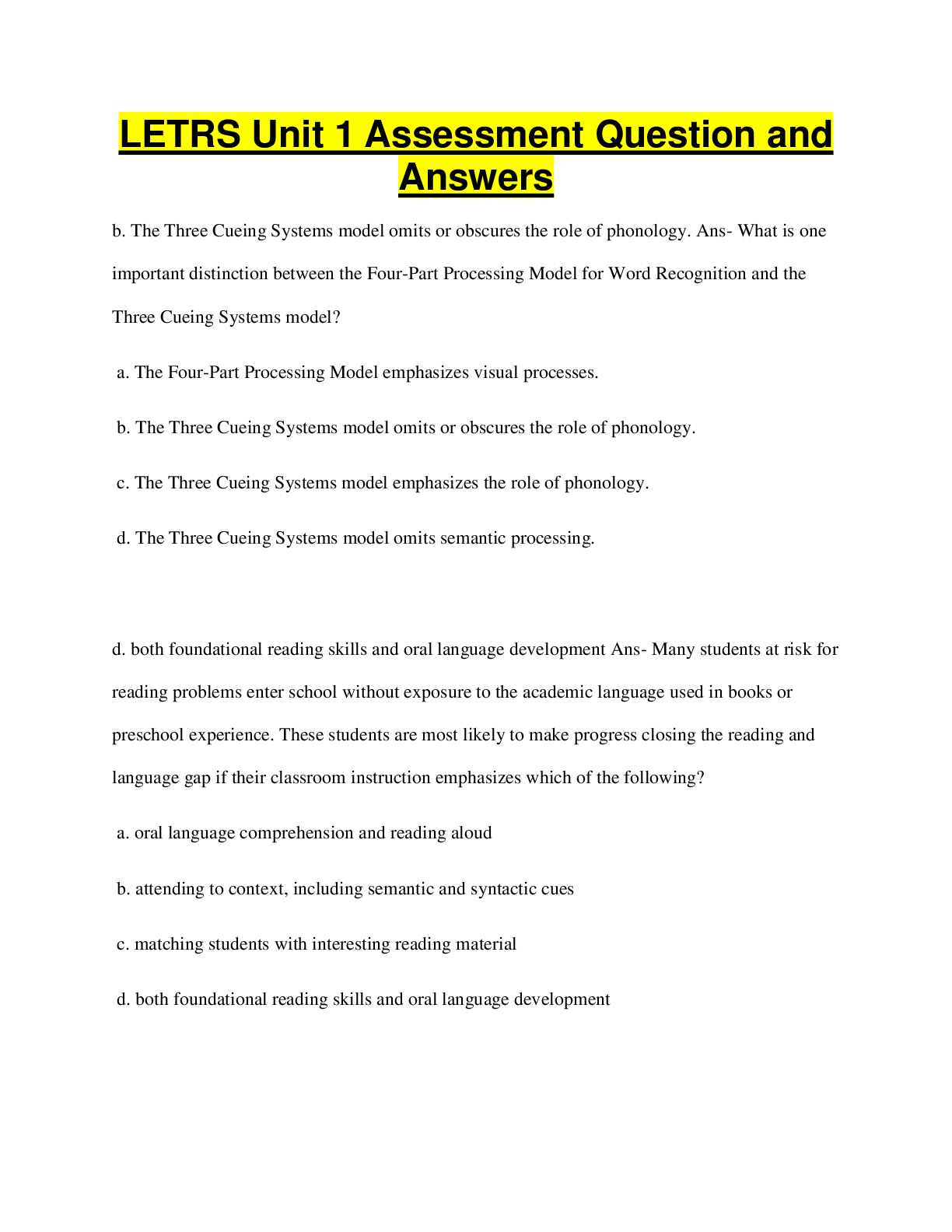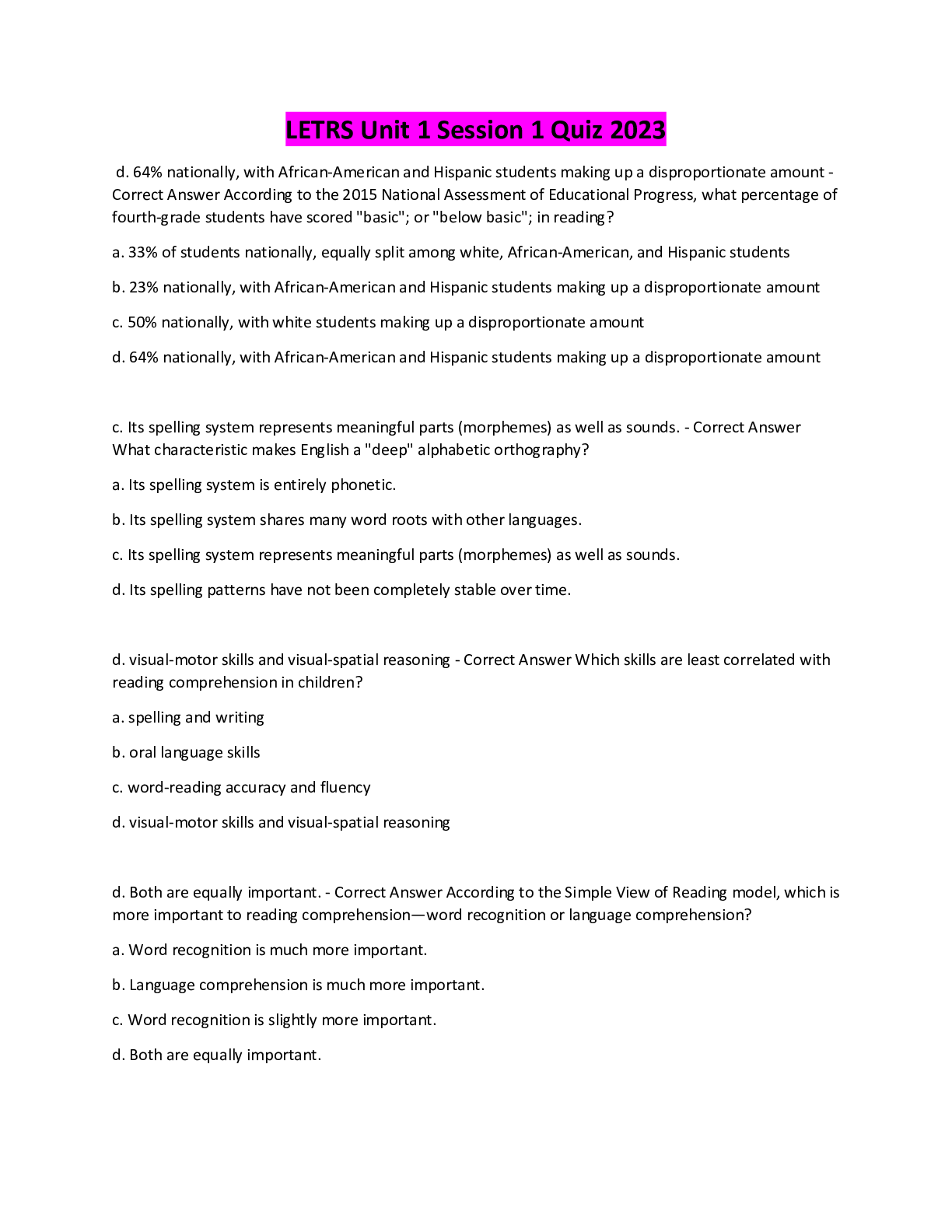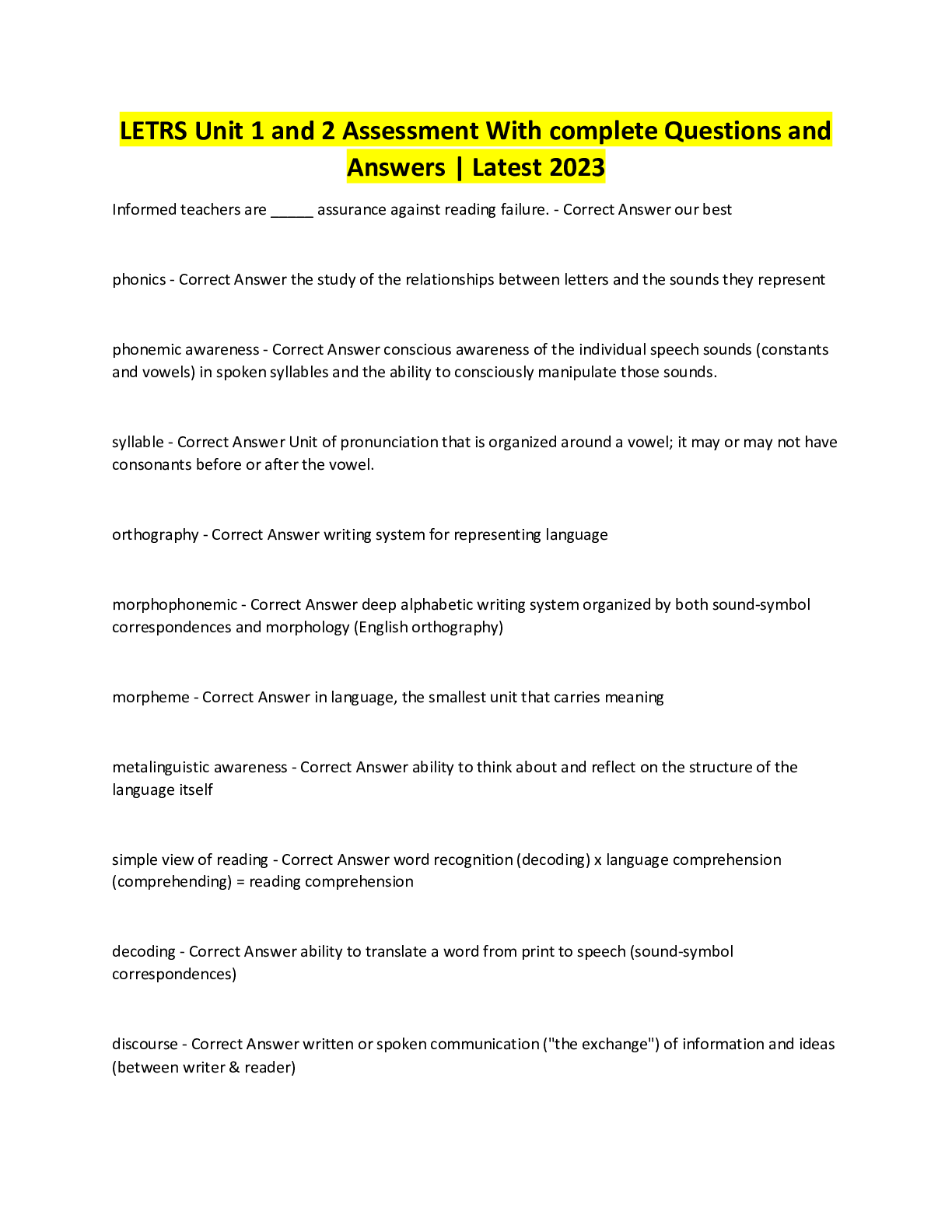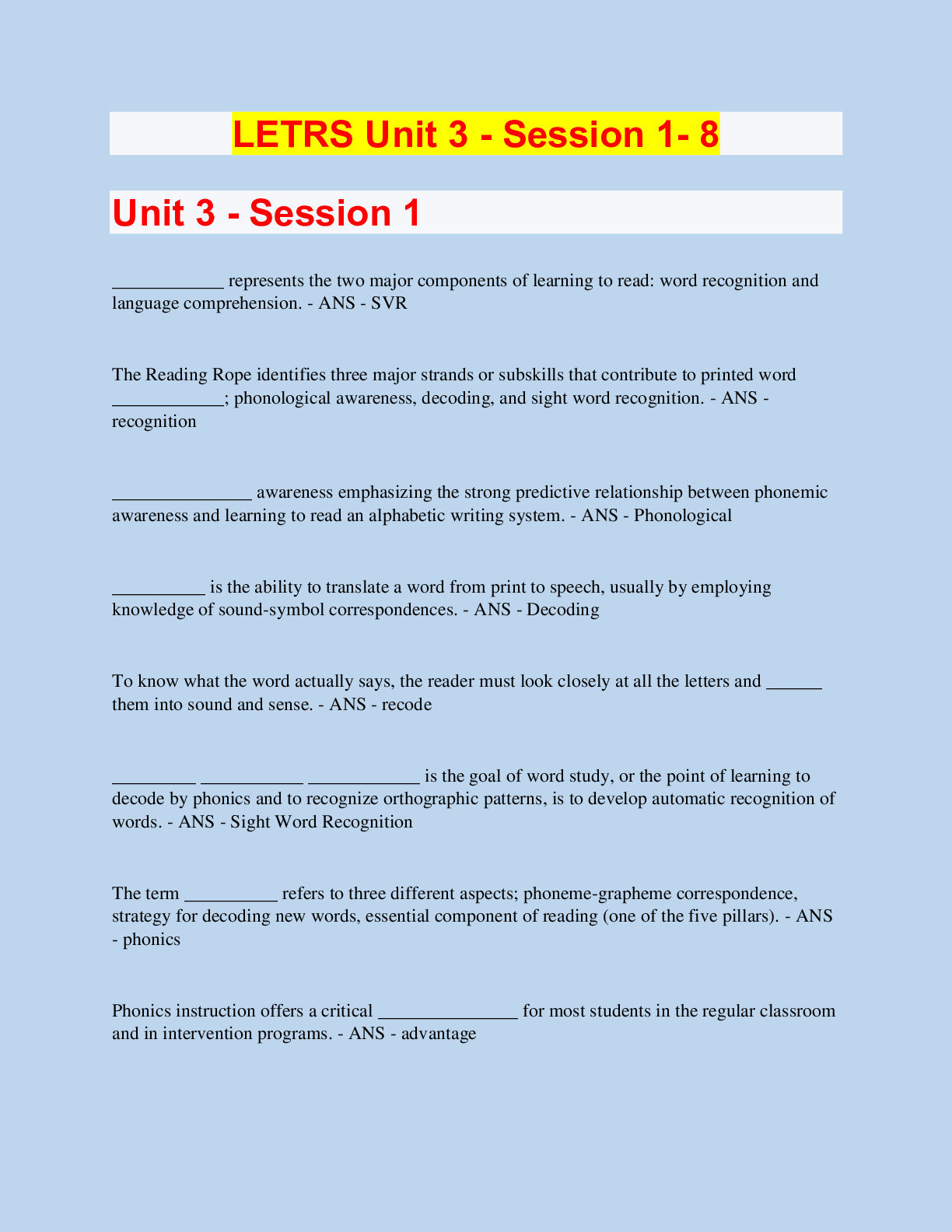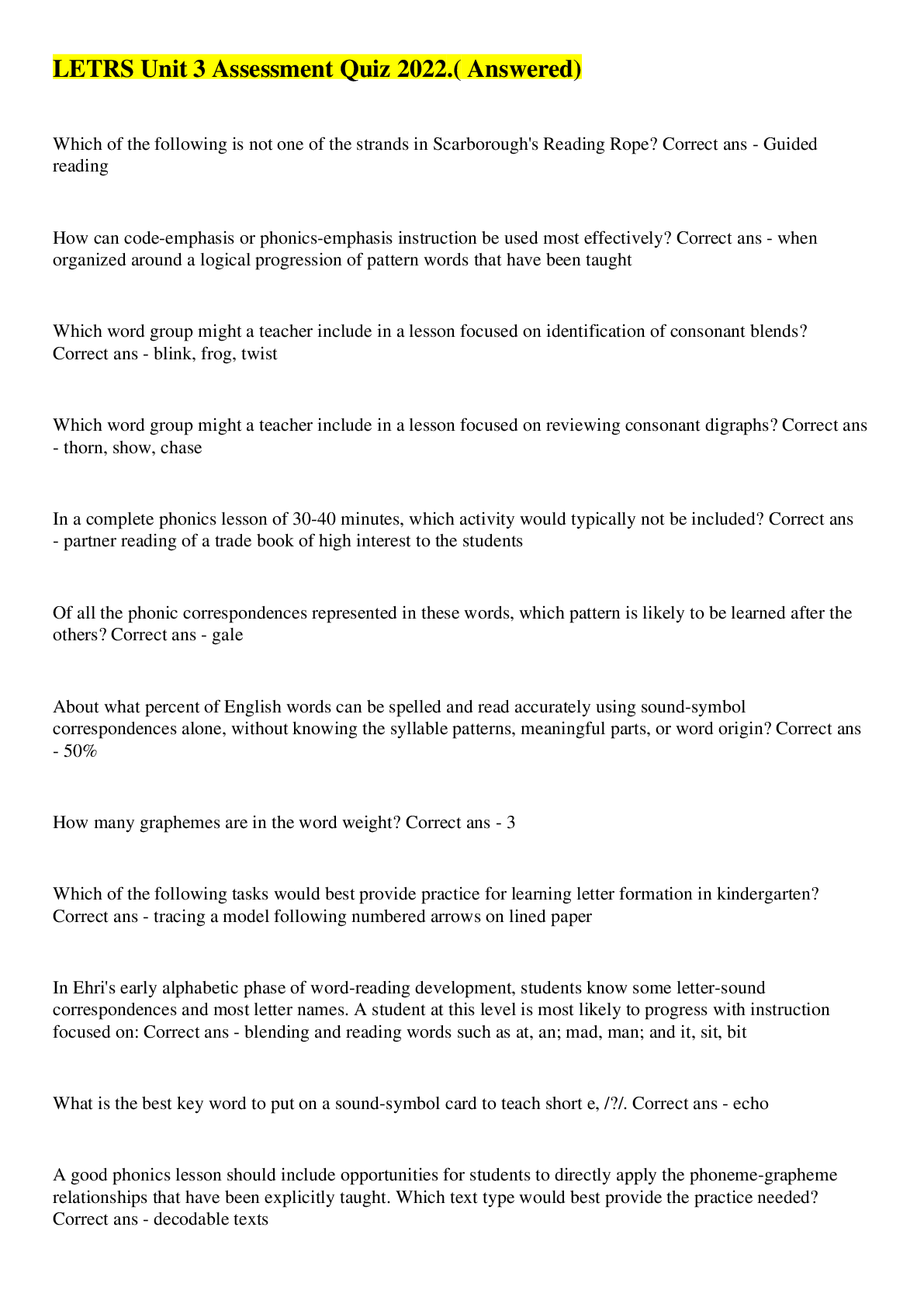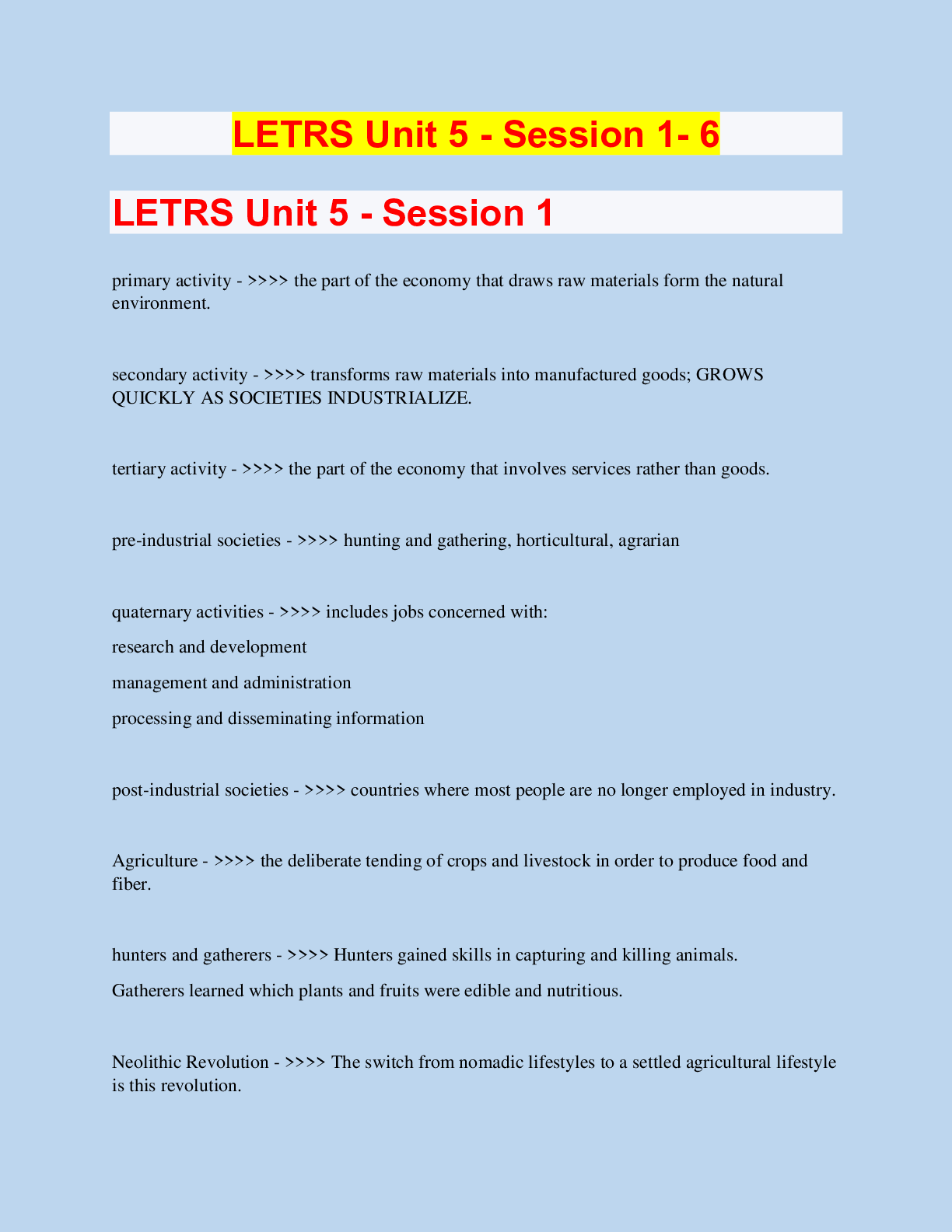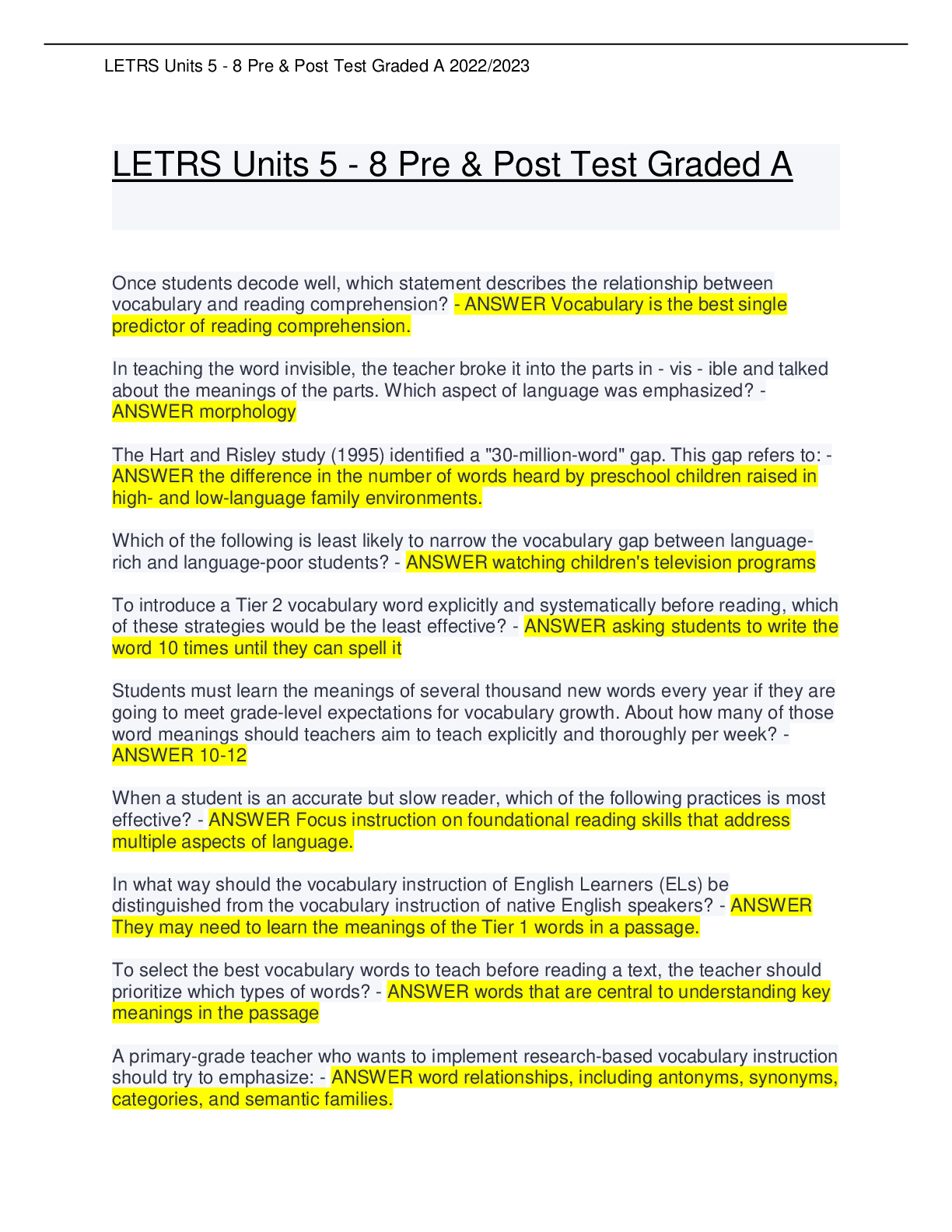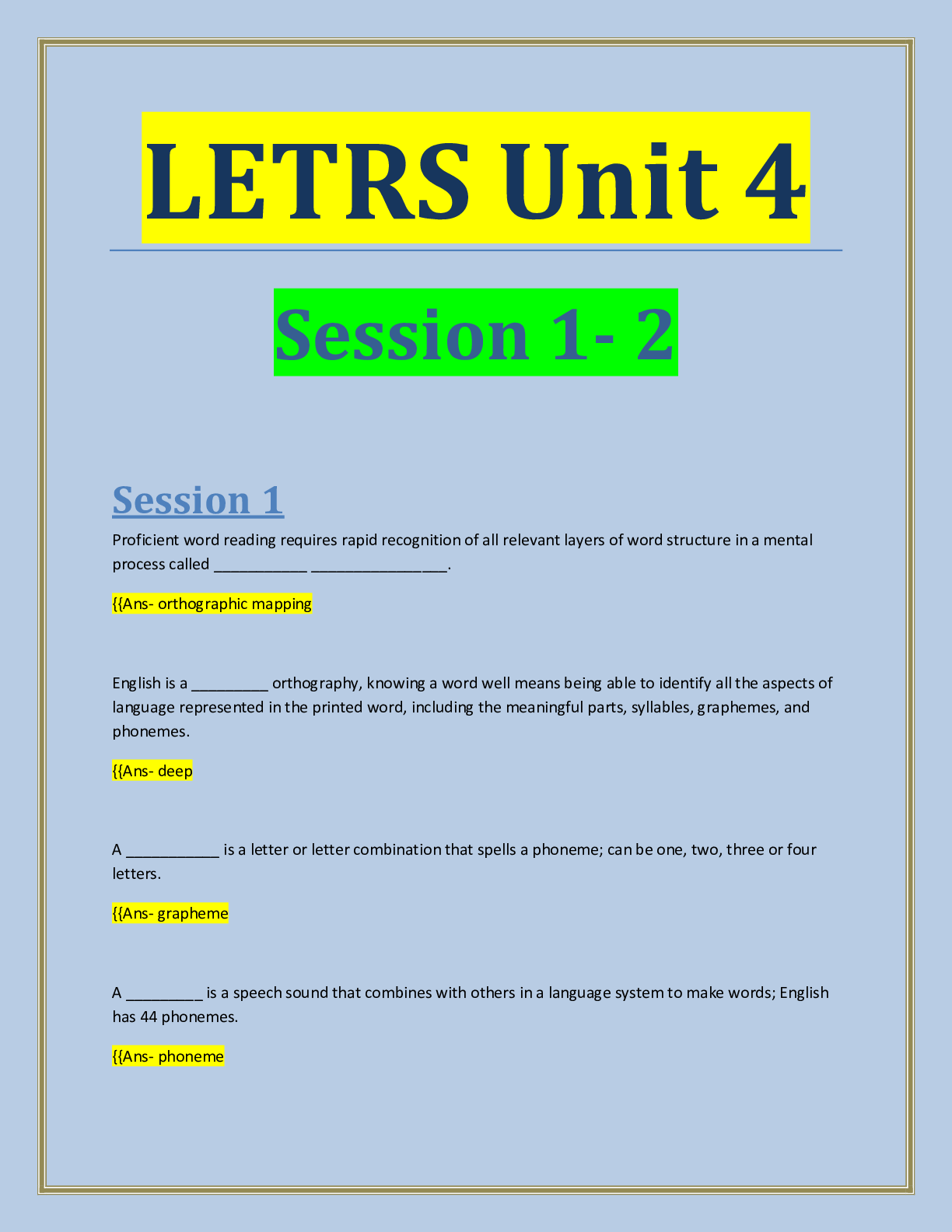Micro Biology > EXAM > BIOL 2421: Microbiology final ocx, Latest 2020/2021 TEST BANK Guide, South Texas College. (All)
BIOL 2421: Microbiology final ocx, Latest 2020/2021 TEST BANK Guide, South Texas College.
Document Content and Description Below
BIOL 2421 Microbiology Final ocx. 1. Microorganisms are best defined as organisms that A. can only be found growing in laboratories. B. are too small to be seen with the unaided eye. C. are infectious... particles. D. lack a cell nucleus. E. cause human disease. 2. Which of the following are not considered microorganisms? A. Fungi B. Protozoa C. Viruses D. Bacteria E. Mosquitoes 3. Helminths are ______. A. molds B. parasitic worms C. bacteria D. protozoa E. infectious particles 4. Among the types of microorganisms, the ______ are noncellular. A. protozoans B. bacteria C. viruses D. helminths *The replication cycles of viruses (lytic and lysogenic) differ among viruses and are determined by their unique structures and genomes. 5. Studies of the immune response to an infection caused by microorganisms would be performed by a(n) ______. A. hypersensitivity specialist B. immunologist C. geomicrobiologist D. epidemiologist Microorganisms, cellular and viral, can interact with both human and nonhuman hosts in beneficial, neutral or detrimental ways. 6. Which of the following pairs of career descriptions and work tasks is not correctly matched? A. Medical microbiologist -- identify the cause of a bladder infection at a hospital lab B. Industrial microbiologist -- manipulate bacterial strains to be less pathogenic C. Agricultural microbiologist -- identify bacterial causes of crop disease D. Public health microbiologist -- track the incidence of AIDS in a population Humans utilize and harness microorganisms and their products. 7. A scientist who studies the influence of microbes in the formation of caves is called a(n) ______. A. astrobiologist B. epidemiologist C. geomicrobiologist D. immunologist Microbes are essential for life as we know it and the processes that support life (e.g., in biogeochemical cycles and plant and/or animal microflora). 8. Astrobiology is considered a sub-discipline of microbiology because A. life elsewhere in the universe is likely to be microbial. B. microbes are known to exist on other planets. C. all extraterrestrials known are microbial. D. only microbes can reproduce under the extreme conditions in outer space. Microorganisms are ubiquitous and live in diverse and dynamic ecosystems. 9. Which of the following does not indicate microbe involvement in energy and nutrient flow? A. Decomposition of dead matter and wastes B. Digestion of complex carbohydrates in animal diets C. Formation of greenhouse gases, CO2 and methane D. Thermal hot springs warmed by heat from earth's interior Microorganisms are ubiquitous and live in diverse and dynamic ecosystems. 10. The microorganisms that recycle nutrients by breaking down dead matter and wastes are called ______. A. fermenters B. eukaryotes C. decomposers D. pathogens E. prokaryotes Bacteria and Archaea exhibit extensive, and often unique, metabolic diversity (e.g., nitrogen fixation, methane production, anoxygenic photosynthesis). Microbes are essential for life as we know it and the processes that support life (e.g., in biogeochemical cycles and plant and/or animal microflora). 11. The majority of oxygen in earth's atmosphere is a product of photosynthesis by ______. A. rain forests B. microorganisms C. green plants D. agricultural lands 12. The three cell types discussed, eukaryotes, archaea, and bacteria, all derived from ______. A. cells with a true nucleus B. the last universal common ancestor C. photosynthetic bacteria D. archaea 13. The first cells appeared about ___ billion years ago. A. 5 B. 4.5 C. 3.5 D. 2 E. 1 14. A hypothesis must be tested many times before it can be considered a theory. TRUE Ability to apply the process of science: Demonstrate an ability to formulate hypotheses and design experiments based on the scientific method. 15. Which area of biology states that living things undergo gradual structural and functional changes over long periods of time? A. Evolution B. Morphology C. Phylogeny D. Genetics E. Transformation The evolutionary relatedness of organisms is best reflected in phylogenetic trees. 16. When humans manipulate the genes of microorganisms, the process is called ______. A. epidemiology B. taxonomy C. bioremediation D. genetic engineering E. immunology Cell genomes can be manipulated to alter cell function. Humans utilize and harness microorganisms and their products. 17. Which activity is an example of biotechnology? A. Bacteria in the soil secreting an antibiotic to kill competitors B. Public health officials monitoring diseases in a community C. Egyptians using moldy bread on wounds D. A microbiologist using the microscope to view bacteria E. Escherichia coli producing human insulin 18. Which of the following is a traditional human use of microorganisms? A. Baking bread B. Cleaning up oil spills C. Treating water and sewage D. Mass-producing antibiotics 19. Using microbes to detoxify a site contaminated with heavy metals is an example of ______. A. biotechnology B. bioremediation C. decomposition D. epidemiology E. immunology 20. Disease-causing microorganisms are called ______. A. pathogens B. decomposers C. fermenters D. bacteria E. eukaryotes 21. The number one worldwide infectious diseases are ______. A. AIDS-related diseases B. malaria and other protozoan diseases C. respiratory diseases D. measles and other rash diseases E. diarrheal diseases 22. Many chronic medical conditions have been found to be associated with microbial agents. TRUE 23. The incidence of deaths from communicable disease is ______ in the United States compared to the entire world. A. less B. greater C. about the same 24. In which way are bacteria and eukaryotes the same? A. Contain a nucleus to hold DNA B. Contain ribosomes for protein synthesis C. Contain membrane-bound organelles D. Have a cell wall for rigidity 25. In which way are archaea and eukaryotes the same? A. Have a cell wall for rigidity B. Can use flagella for movement C. Contain mitochondria for energy production D. Contain membrane-bound organelles 26. All bacteria and archaea are microorganisms, but only some eukaryotes are microorganisms. TRUE 27. Which of the following is a unique characteristic of viruses that distinguishes them from the other major groups of microorganisms? A. Cannot be seen without a microscope B. Contain genetic material C. Cause human disease D. Lack a nucleus E. Lack cell structure 28. Organisms called parasites are ______. A. the decomposers in ecosystems B. always viruses C. always harmful to their host D. free-living 29. Which group of microorganisms is composed only of hereditary material wrapped in a protein covering? A. Yeasts B. Parasites C. Viruses D. Fungi E. Bacteria 30. Eukaryotic cells are larger than bacterial or archaeal cells; all cells are larger than macromolecules. Where do viruses fit on this scale? A. Viruses are smaller than eukaryotic cells, but larger than bacterial or archaeal cells. B. Viruses are smaller than macromolecules. C. Viruses are larger than eukaryotic cells. D. Viruses are smaller than bacterial or archaeal cells, but larger than macromolecules. 31. In general, eukaryotic cells are about ______ times larger than bacterial or archaeal cells. A. 2 B. 10 C. 50 D. 1000 32. Archaeal cells are about ______ bacterial cells. A. ten times smaller than B. the same size as C. ten times larger than 33. Many chronic infections are caused by microbes that associate in communities termed ______. A. biofilms B. virions C. microbiota D. sediments 34. Which of the following historical microbiologists is incorrectly paired with his contribution to the science? A. Francesco Redi: tested spontaneous generation with meat exposed to the air or covered with cloth B. Louis Pasteur: demonstrated that anthrax was caused by a bacterium C. Joseph Lister: promoted disinfecting hands and air prior to surgery D. Antonie van Leeuwenhoek: made and used quality magnifying lenses to observe and record microorganisms 35. In the experiments constructed by Pasteur to disprove spontaneous generation, swan-necked flasks were used. Why was this shape of flask used in this experiment? A. The shape of the glass neck allowed the bacteria into the flask and then into the media, but air could not enter. B. The glass necks needed to be open to the air, yet constructed so that bacteria would settle in the lowest part of the neck. C. These flask shapes were the easiest and cheapest to produce. D. Because the glass necks were stretched out, the heat used to sterilize the medium inside of the flask could not kill the bacteria in the neck. 36. Koch's postulates are criteria used to establish that A. microbes are found on dust particles. B. a specific microbe should be classified in a specific kingdom. C. microbes can be used to clean up toxic spills. D. a specific microbe is the cause of a specific disease. E. life forms can only arise from preexisting life forms. 37. Which of the following is NOT a recent discovery that has had a huge impact on the understanding of microbiology? A. Restriction enzymes B. PCR technique C. Biofilms D. Small RNAs E. All are significant discoveries. 38. The sum total of all the microbes in a certain environment is termed the ______. A. microbiome B. microbial niche C. domain D. biofilm E. phylogeny 39. Which of the following is not a process in the scientific method? A. Systematic observation B. Development of a theory C. Laboratory experimentation D. Formulation of a hypothesis E. Belief in a preconceived idea 40. Experimentation A. is the first step in the scientific method. B. is designed to support an hypothesis. C. provides a means to gather objective data. D. is designed to refute an hypothesis. E. provides a means to gather subjective data. 41. The scientific method includes all of the following except ______. A. experimentation B. hypothesis 42. The scientific method involves formulating a tentative explanation, called the hypothesis, to account for what has been observed or measured. TRUE 43. Caring for patients infected with a new virus requires safety precautions for medical personnel. Choosing appropriate procedures is an example of a(n) ______ process. A. pathogenic B. deductive C. hypothetical D. inductive 44. Sterile refers to ______. A. homogenized B. absence of any life forms and viral particles C. pathogen-free D. pasteurized E. absence of spores lo 45. Taxonomy does not involve ______. A. classification B. a common name C. nomenclature D. identification 46. Which scientific field is involved in the identification, classification, and naming of organisms? A. Nomenclature B. Epidemiology C. Taxonomy D. Phylogeny E. Pathology 47. The orderly arrangement of organisms into a hierarchy of taxa is called ______. A. experimentation B. biotechnology C. classification D. identification E. nomenclature 48. Members of the same species share many more characteristics compared to those shared by members of the same kingdom. TRUE 49. Which of the following is a taxon that contains all the other taxa listed? A. Family B. Genus C. Kingdom D. Species E. Phylum 50. The smallest and most significant taxon is a ______. A. kingdom B. phylum C. species D. family E. genus 51. Select the correct descending taxonomic hierarchy (left to right). A. Class, phylum, order B. Family, genus, species C. Kingdom, domain, phylum D. Family, order, class E. Genus, species, family 52. A recently-developed mnemonic for remembering the taxonomic levels from Domain to Species is "Dumb Kids Prefer Candy Over Fancy Green Salad." The word "candy" here is a reminder of the taxonomic level of _______. A. chain B. culture C. category D. colony E. class 53. Which of the following is a scientific name? A. Streptobacilli B. Gram-positive streptococcus C. Anthrax D. Streptococcus pyogenes 54. When assigning a scientific name to an organism, A. the species name is placed first. B. the species name can be abbreviated. C. both genus and species names are italicized or underlined. D. both genus and species names are capitalized. E. the species name is capitalized. 55. Which scientific name is written correctly? A. S. aureus B. Staphylococcus aureus C. Staphylococcus Aureus D. staphylococcus aureus E. Staphylococcus aureus 56. The names of the three proposed domains are: Bacteria, Protista, and Eukarya. FALSE 57. A diagram of the three domains (Bacteria, Archaea, Eukarya) proceeding from the Last Universal Common Ancestor would show Archaea A. branching off the Domain Bacteria. B. branching off the Domain Eukarya. C. as the original cells from which the others derived. 58. Analysis of the small subunit rRNAs from all organisms in the three current domains suggests that A. the prokarytoes, archaea, and eukaryotes are not related. B. the eukaryotes arose from prokaryotes. C. the Archaea are more closely related to bacteria than eukaryotes. D. all modern and extinct organisms on earth arose from a common ancestor. 59. The study of evolutionary relationships among organisms is called ______. A. genetics B. biotechnology C. phylogeny D. taxonomy E. recombinant DNA 60. A scientist studying the sequence of nucleotides in the rRNA of a bacterial species is working on A. recombinant DNA. B. nomenclature. C. determining evolutionary relatedness. D. bioremediation. E. determining if that species is the cause of a new disease. 61. Trees of life that illustrate the phylogenetic relationships of all organisms were traditionally based on ______; newer methods for determining phylogeny rely on ______. A. morphology; virology B. nucleic acid sequences; morphology C. morphology; nucleic acid sequences D. nucleic acid sequences; microbiomes E,morphology; nutritional requirements CH-02: 1. An atom has gained an electron; it has been ______. A. ionized B. oxidized C. neutralized D. reduced E. deionized 1. Anything that occupies space and has mass is called ______. A. matter B. energy C. living D. space E. atomic 2. The electrons of an atom are A. moving in pathways called orbitals. B. used to determine atomic number. C. positively charged. D. always equal to the number of neutrons in an atom. E. found in the nucleus. 3. The electrons of an atom are A. used to determine the atomic weight. B. always equal to the number of protons. C. carrying a positive charge. D. always in full orbitals. E. used to determine the atomic number. 4. All of the following pertain to the atom Carbon-14 except it A. has 14 neutrons. B. is an isotope of carbon. C. has 6 protons. D. has 6 electrons. 5. The subatomic particles that surround the nucleus are the ______. A. protons and neutrons B. neutrons C. electrons D. protons E. protons and electrons B. 6. What is the maximum number of electrons in the second energy shell of an atom? A. 2 B. 4 C. 8 D. 18 E. 32 7. What is the maximum number of electrons in the first energy shell of an atom? A. 2 B. 4 C. 8 D. 18 E. 32 8. Protons and neutrons make up the atom's central core, which is referred to as its ______. A. isotope B. center of gravity C. valence number D. nucleus 9. The valence number is the A. number of protons. B. atomic weight. C. number of neutrons. D. number of electrons in the innermost orbital. E. number of electrons in the outermost orbital. 10. Two or more atoms bonded together are called a(n) ______. A. molecule B. isotope C. ion D. electrolyte E. element 11. What would be the valence number of electrons in the sulfur (S) atom? Its atomic number is 16. A. 2 B. 6 C. 8 D. 16 E. 32 12. Polar molecules A. always contain carbon. B. have an equal charge distribution. C. have an unequal charge distribution. D. always involve oxygen. E. are insoluble in water. 13. Organic chemicals always have a basic framework of the element _____ bonded to other atoms. A. oxygen B. phosphorous C. nitrogen D. hydrogen E. carbon 14. C6H12O6 C6H12O6 C12 H22O11 H2O represents A. the formation of a polysaccharide. B. the formation of a peptide bond. C. a decomposition reaction. D. a denaturation reaction. E. a dehydration synthesis. 15. Electrons that participate in chemical bonding are typically located closest to the nucleus. FALSE 16. Substances that release ions when dissolved in water and conduct electricity are ______. A. covalent B. solvents C. nonpolar D. electrons E. electrolytes 16. A capillary tube is used to acquire a small blood sample for CBC (complete blood count) analysis. Suction is not required to transfer the blood from the fingertip prick to the tube in part due to A. covalent bonding between the water molecules. B. cohesive forces between the glass particles of the tube and the water molecules. C. ionic bonding between the water molecules. D. adhesive forces between the water molecules and the glass particles of the tube. 17. Polar molecules are composed of covalently bonded A. carbon atoms. B. ions. C. identical atoms. D. atoms of identical electronegativity. E. atoms of different electronegativity. 18. Covalent bonds A. result from gaining electrons. B. are always nonpolar. C. result from losing electrons. D. are always polar. E. result from sharing electrons. 19. Cations are A. atoms without protons. B. charged subatomic particles. C. atoms that have gained electrons. D. capable of forming ionic bonds with anions. E. atoms that have gained neutrons. 20. A reaction where an electron is lost is called ______. A. oxidation B. reduction C. ionization D. decomposition E. dissolution 21. Ionic bonds A. result from like charge attraction. B. result from transferring electrons. C. are the weakest chemical bonds. D. always involve carbon. E. result from sharing electrons. 22. Hydrogen bonds A. result from attractive forces between molecules with polar covalent bonds. B. are the strongest bonds between molecules. C. result from attractive forces between molecules with polar ionic bonds. D. result from attractive forces between molecules with nonpolar ionic bonds. E. result from attractive forces between molecules with nonpolar covalent bonds. 23. Atoms that gain or lose electrons become charged particles called ______. A. ions B. isotopes C. anions D. cations 24. Which of the following represents a synthesis reaction? A. AB A B B. A B AB C. AB XY AY XB D. AB XY AY XB 25. Which of the following represents a reversible reaction? A. A B AB B. AB A B C. AB XY AY XB D. AB XY AY XB 26. Ionic compounds A. are basic in solution. B. are acidic in solution. C. are hydrophobic. D. are hydrophilic. E. always form salts in solution. 27. Water molecules are nonpolar molecules. FALSE 28. Polar molecules have more reactivity compared to nonpolar molecules. TRUE 29. A covalent bond is formed between an anion and a cation. FALSE 30. The important solvent associated with living things is ______. A. benzene B. sodium chloride C. water D. carbon dioxide E. ethyl alcohol 31. The concentration of a solution expresses the amount of solvent present. FALSE 32. In the cell cytoplasm, molecules of ATP are a ______. A. solute B. solvent 33. Burning coal produces sulfur dioxide in the atmosphere. When combined with rain that falls into bodies of water, this leads to A. a greater concentration of OH- ions in the water. B. a decrease in the pH level of the water. C. an increase in pH level of the water. D. no change in the pH level of the water. 34. Compared to a solution of pH 9, a solution of pH 7 A. is more basic. B. has more H ions. C. has a higher pH. D. has no OH- ions. 35. Compared to a solution of pH 9, a solution of pH 7 is A. 20 times more basic. B. 2 times more acidic. C. 100 times more acidic. D. 100 times more basic. E. 20 times more acidic. 36. If solution A has a lower pH compared to solution B, then solution A is more acidic than solution B. TRUE 37. One technique for staining bacteria for viewing under the microscope is called the Gram stain. In this technique, alcohol is used as a decolorizer because it degrades the outer membrane found in some bacteria. What chemical component of the cell does alcohol affect? A. Protein B. Lipid C. Nucleic acids D. Carbohydrate 38. What type of bond is formed by dehydration synthesis between two amino acids? A. Ester B. Peptide C. Phosphate D. Disulfide E. Glycosidic 39. The purine ______ always hydrogen bonds with the pyrimidine ______ in double-stranded DNA. A. cytosine; guanine B. thymine; guanine C. guanine; cytosine D. adenine; guanine 40. The only part of an amino acid that differs from other amino acids is its R group. TRUE 41. In what way would life be different if the element carbon was absent? A. There would be no organic compounds. B. There would be no inorganic compounds. C. Life would not exist in any shape or form. D. The concept of pH would not exist. 42. A student forgot to label a beaker containing a DNA solution and a beaker containing a glucose solution. If chemical analysis was performed to identify the contents of each beaker, which of the following would be found in the beaker of DNA but not in the beaker with glucose? A. Nitrogen and phosphorus B. Carbon atoms C. Hydrogen and oxygen atoms D. Fatty acids E. Amino acids 43. All proteins are enzymes. FALSE 44. Which of the following functional groups is mismatched to the organic compound in which it is typically found? A. Carboxyl - fatty acids B. Amino - proteins C. Hydroxyl - alcohols D. Sulfhydryl - proteins E. Phosphate - carbohydrates 45. Most biochemical macromolecules are polymers, which are chains of ______. A. hydrophobic molecules B. hydrogen bonds C. repeating carbohydrates D. electrolytic molecules E. repeating monomers 46. All of the following are monosaccharides except ______. A. glycogen B. fructose C. glucose D. deoxyribose 47. Which of the following would have glycosidic bonds? A. Monosaccharides B. Polypeptides C. Triglycerides D. ATP E. Polysaccharides 48. Starch is the primary storage food for all of the following except ______. A. algae B. some fungi C. green plants D. animals 49. Select the statement that most accurately reflects the process of plant material digestion in humans. A. It requires the action of enzymes called kinases. B. It is linked to the digestion of glycogen. C. It is a process that is dependent upon enzyme (cellulase) production by gut microbiota. D. It is a very efficient process the produces very little undigested material in feces. 50. All of the following are lipids except ______. A. wax B. cholesterol C. phospholipid D. starch E. triglyceride 51. What part of a phospholipid comprises the hydrophobic tail? A. Alcohol B. Hydroxyl C. Phosphate D. Glycerol E. Fatty acids 52. A fat is called _____ if all carbons of the fatty acid chain are single-bonded to 2 other carbons and 2 hydrogens. A. monounsaturated B. unsaturated C. polyunsaturated D. saturated 53. The building blocks of an enzyme are ______. A. nucleotides B. monosaccharides C. amino acids D. glycerol and fatty acids E. phosphate, glycerol, and fatty acids 54. An amino acid contains all of the following except a/n ______. A. phosphate B. carbon C. carboxyl group D. variable R group E. amino group 55. An example of an amphipathic molecule found in living cells is ______. A. phospholipid B. nucleic acid C. protein D. ATP E. glucose 56. The lipid group that serves as energy storage molecules is the ______. A. triglycerides B. prostaglandins C. steroids D. phospholipids E. waxes 57. All of the following are polysaccharides except A. dextran in some bacterial slime layers. B. agar used to make solid culture media. C. cellulose in certain cell walls. D. sterols in cell membranes. E. a cell's glycocalyx. 58. The lipid group that is the major component of cell membranes is the ______. A. waxes B. steroids C. prostaglandins D. triglycerides E. phospholipids 59. Nucleic acids have primary, secondary, tertiary, and quaternary levels of organization. FALSE 60. Which of the following statements is incorrect regarding protein structure? A. Proteins, such as antibodies that are comprised of multiple polypeptide chains, have quaternary structure. B. The folding of a protein to form its active site creates its tertiary structure. C. Beta-pleated sheets are a type of protein secondary structure. D. The sequence of nucleotides determines the primary structure of a protein. 61. Which of the following is not true about enzymes? A. Enzymes are found in all cells. B. Enzymes can be denaturated by heat and other agents. C. Enzymes participate in the cell's chemical reactions. D. Enzymes have high-energy bonds between phosphates. E. Enzymes are catalysts. 62. The alpha () helix is a type of _____ protein structure. A. primary B. secondary C. tertiary D. quaternary 63. The most important outcome of polypeptide intrachain bonding and folding is the unique shape of the protein. TRUE 64. ATP differs from the nucleotides found in DNA in the A. use of phosphate instead of sulfate in the backbone. B. use of phosphorus in the nitrogenous base portion of the molecule. C. sugar portion of the molecule. D. use of uracil in the nitrogenous base portion of the molecule. E. use of adenosine instead of adenine. 65. A new organism was identified that contained arsenic in place of phosphate in its DNA double helix structure. Based upon this information alone, it can be determined that this change will greatly alter the information encoded by this genetic material. FALSE 66. One nucleotide contains one A. phosphate. B. pentose sugar. C. nitrogen base. D. All of the choices are correct. 67. Purines and pyrimidines are components in the building block units of all ______. A. amino acids B. polysaccharides C. carbohydrates D. enzymes E. nucleic acids 68. Which of the following is not a pyrimidine? A. Adenine B. Thymine C. Cytosine D. Uracil 69. Which pertains to DNA but not to RNA? A. Contains ribose B. Contains nucleotides C. Contains thymine D. Contains adenine E. Contains uracil 70. Which of the following is a correct description of a component of the ATP molecule? A. Sugar: deoxyribose B. Sugar: ribose C. Nitrogenous base: alanine D. High energy bond: peptide bond E. High energy bond: glycosidic bond 71. ATP is best described as A. a double helix. B. the energy molecule of cells. C. an electron carrier. D. an enzyme. 72. A culture of an organism believed to cause intestinal symptoms is viewed under the microscope, and the microbiologist observes a cell membrane, flagella, mitochondria, and some dark unrecognizable structures within each cell. The microbiologist notes that the cells are eukaryotic because A. the dark structures must be the cell nuclei. B. only eukaryotic cells have a cell membrane. C. only eukaryotic cells have flagella. D. only eukaryotic cells have mitochondria. 73. NASA has published a list of criteria for identifying fossil bacteria in samples from Mars, as part of a search for evidence of life. Which of the following is good evidence for the presence of bacterial cells? A. Three-dimensional organization of cells in a starburst pattern B. No evidence of water in the surrounding mineral C. Cell size of 0.5 to 2 microns D. Absence of carbon in the material 74. Characteristics shared by all cells include A. a membrane serving as a cell boundary. B. the possession of genetic information. C. the presence of cellular fluid. D. All of the choices are correct. 75. All cells contain A. uracil in their DNA. B. ribosomes for protein synthesis. C. cell walls made of cellulose. D. organelles for compartmentalization. E. mitochondria to generate ATP CH-03: Micro Multiple Choice Questions 1. A microbiologist inoculates Staphylococcus aureus into a culture medium. Following incubation, both Staphylococcus aureus and Staphylococcus epidermidis are determined to be growing in this culture. What is the most likely explanation? A. The microbiologist used too much inoculum. B. The culture medium was selective. C. The culture medium was differential. D. The culture was contaminated. E. The incubation temperature was incorrect. 2. A microbiologist inoculates Staphylococcus epidermidis and Escherichia coli into a culture medium. Following incubation, only the E. coli grows in the culture. What is the most likely explanation? A. The culture medium was selective. B. The culture medium was differential. C. The microbiologist used too much inoculum. D. The culture was contaminated. E. The incubation temperature was incorrect. 3. Robert Koch and his colleagues first used agar in bacteriological media. Why was this ingredient an improvement on previous materials used to culture bacteria? A. Agar can convert from liquid to solid form, and back again, very easily. B. Agar is a complete source of nutrients for most bacteria. C. Bacteria growing on the solidified medium did not degrade or break down the agar. D. Agar was less expensive than the nutrients that Koch was previously using in the lab. 4. The bacterium Neisseria gonorrhoeae causes the sexually-transmitted infection gonorrhea. Although it can be isolated from the vagina, there are numerous normal biota in that location as well. To generate a pure culture of this pathogenic bacterium, the best choice is a(n) ______. A. differential medium B. enrichment medium C. selective medium D. liquid medium 5. Thioglycolate medium contains the following: yeast extract, pancreatic digest of casein, glucose, L-cysteine, sodium chloride, sodium thioglycolate, and agar. It is considered a complex medium because A. depending on their oxygen utilization pattern, organisms will grow differently on it. B. it has multiple ingredients for a broad range of nutrients. C. both yeast extract and pancreatic digest of casein are not chemically defined. D. thioglycolate has a carbon-sulfur bond that many microbes cannot break enzymatically. 6. Humans can see objects as small as 0.1 mm. Leeuwenhoek's best microscope could magnify objects to 300X. Which of the following would be invisible using Leeuwenhoek's microscope? A. Poliovirus, 30 nm F. Red blood cell, 8 m C. Escherichia coli, 1 m X 4 m D. Pandora virus, 0.5 mm X 1 mm 7. Cells of Staphylococcus aureus are cocci measuring about 1 m in diameter. In a textbook image of S. aureus, each cell measures about 1 cm. The magnification of the image on the page is ______. A. 10,000X B. 1,000X C. 100X D. 0.01X E. 0.001X F. 0.0001X G. This is impossible to calculate without more information. 8. Table 3.6 in your textbook uses Paramecium to illustrate several types of light microscopy. Each image is magnified 230X and measures about 4 cm. The actual size of a Paramecium is about ______. A. 920 m B. 0.2 m C. 175 m D. 57.5 m E. 4,000 m 9. Your microscope has a resolving power of 0.15 m. The specimen that you will be observing has bacterial cocci the size of 0.1 m in diameter. Which of the following statements is correct? D. The cocci will appear much smaller than their actual size because of the low resolution. B. The cocci will be fuzzy-looking and blend together. C. The cocci will not be visible. D. The cocci will be readily visible and distinct. 10. A microbiology student with a visual disability is viewing a sample of Bacillus endospores in a phase contrast microscope that is linked to an iPad. By "stretching" the image on the iPad screen, the student can increase the apparent size of the endospores. How does this manipulation affect resolution and contrast? (No software is being used to alter the image!) A. Only the magnification can be increased; resolution and contrast are unchanged. B. Contrast will improve because the microscope is phase-contrast. C. Both magnification and resolution increase; contrast is unchanged. D. Resolution and magnification will decrease because the screen is not as good as the human eye. 11. Agar is an important component of media because A. agar provides a solid surface for bacterial growth. B. bacteria require agar as a source of carbon. C. agar inhibits mold growth. D. agar prevents contamination. 12. The Five I's of studying microorganisms include all of the following except ______. A. identification B. isolation C. incubation D. infection E. inoculation 13. The term that refers to the purposeful addition of microorganisms into a laboratory nutrient medium is ______. A. inoculation B. contamination C. infection D. immunization E. isolation 14. A pure culture contains A. only bacteria. B. only one identified species of microorganism. C. a variety of species from the same genus. D. microbes from a single source. 15. The correct microbiological term for the sample of specimen that is put into a nutrient medium to produce a culture is ______. A. loop B. inoculum C. streak D. colony 16. Which isolation technique is most effective for the majority of applications and is most commonly used for colony isolation in the laboratory? A. Spread plate B. Streak plate C. Pour plate D. Culture plate E. Loop dilution 17. Which of the following is not an inoculating tool? A. Pipette B. Swab C. Petri dish D. Loop E. Needle 18. What is the term for a culture made from one isolated colony? A. Axenic B. Mixed C. Pure D. Both axenic and mixed are correct. E. Both axenic and pure are correct. 19. Newly inoculated cultures must be _____ at a specific temperature and time to encourage growth. A. incubated B. streaked C. spread D. poured 20. The procedures for culturing a microorganism require the use of a microscope. FALSE 21. Some microbes are not capable of growing on artificial media as pure cultures. TRUE 22. Mixed cultures are also referred to as contaminated cultures. FALSE 23. Bacterial cultures are easily identified from their microscopic appearance. FALSE 24. Which method often results in colonies developing down throughout the agar along with some colonies on the surface? A. Spread plate B. Pour plate C. Replica plate D. Streak plate 25. All of the following are examples of different types of microbiological media except ______. A. agar B. enriched C. broth D. Petri dish E. semisolid 26. Which of the following is essential for the development of discrete, isolated colonies? A. Solid medium B. Differential medium C. Broth medium D. Assay medium E. Selective medium 27. Which of the following is produced by adding 1% to 5% agar to nutrient broth that is then boiled and cooled? A. A pure culture B. A contaminated medium C. A liquid medium D. A mixed culture E. A solid medium 28. The three physical forms of laboratory media are ______. A. solid, semisolid, and liquid B. reducing, transport, and enumeration C. a streak plate, a pour plate, and a broth D. solid, liquid, and gas 29. Agar is a complex polysaccharide that comes from a/an ______. A. bacterium B. algae C. fungus D. marine invertebrate E. green plant 30. Which of the following is not a benefit of agar as a solid medium? A. Holds moisture B. Flexibility C. Solid at room temperature D. Can be inoculated and poured at a temperature that is not harmful E. Easily digested by most microbes 31. A medium that is gel-like has less agar in it compared to a solid medium. TRUE 32. Which type of medium would be the best choice when shipping a sample of bacteria from a clinic to a laboratory for testing? A. Thioglycolate medium B. Eosin-methylene blue agar C. Transport medium D. Blood agar 33. A common medium for culturing fastidious bacteria is ______. A. trypticase soy agar B. reducing medium C. mannitol salt agar D. blood agar E. MacConkey medium 34. A reducing medium contains A. sugars that can be fermented. B. extra oxygen. C. hemoglobin, vitamins, or other growth factors. D. substances that remove oxygen. E. inhibiting agents. 35. Which type of medium distinguishes different types of microorganisms based on an observable change in the colonies or in the medium? A. Enriched B. Enumeration C. Selective D. Reducing E. Differential 36. Differential media result in which of the following observable characteristics? A. Differently colored colonies B. Different media color after incubation C. Chemical precipitates D. Gas bubbles E. All of the choices are correct. 37. A reducing medium is used to culture ______ organisms. A. fastidious B. pathogenic C. anaerobic D. aerobic 38. Mannitol salt agar is selective for organisms in which bacterial genus? A. Salmonella B. Staphylococcus C. Escherichia D. Neisseria E. Streptococcus 39. A microbiologist must culture a patient's feces for intestinal pathogens. Which of the following components would likely be present in a selective medium for this purpose? A. Thioglycolic acid B. Sheep red blood cells C. Bile salts D. Peptone E. NaCl 40. Bacteria that require special growth factors and complex nutrients are termed ______. A. fermentative B. hemolytic C. fastidious D. aerobic E. anaerobic 41. A selective medium contains one or more substances that inhibit growth of some microbes to facilitate the growth of other desired microbes. TRUE 42. Eosin-methylene blue agar, or EMB, is a commonly used bacteriological medium for growing gram-negative bacteria from complex environments. It contains two dyes, eosin and methylene blue, as well as the sugar lactose. Eosin is a pH indicator that changes color when the medium is acidic, while methylene blue inhibits the growth of most gram-positive bacteria. If an organism consumes lactose, acid will be produced, causing the bacterial colonies to change color. Based upon this description, this medium is ______. A. reducing B. for enrichment C. selective D. differential and selective E. differential 43. A nutrient medium that has all of its chemical components identified and their precise concentrations known and reproducible is termed ______. A. reducing B. enriched C. complex D. defined 44. A nutrient medium that contains at least one ingredient that is not chemically defined is termed ______. A. enriched B. complex C. reducing D. synthetic 45. All of the following are diameters of cells that would be resolved in a microscope with a limit of resolution of 0.2 µm except ______. A. 0.2 mm B. 0.1 µm C. 2.0 µm D. 0.2 µm 46. Who invented the first crude microscope by grinding glass? A. Lister B. Schultz and Schwann C. Leeuwenhoek D. Redi E. Pasteur 47. The simple microscopes used by the earliest practitioners of microscopy contained which of the following? A. Magnifying lens B. Oil-immersion lens C. Lamp D. Ocular E. Condenser 48. The _____ of the microscope holds and allows selection of the objective lenses. A. ocular B. condenser C. stage D. nosepiece 49. Which of the following parts of a microscope magnifies the specimen to produce a real image of the specimen? A. Body B. Condenser C. Objective lens D. Ocular lens E. Nosepiece 50. Which of the following parts of the microscope magnifies the specimen to produce the virtual image of the specimen? A. Ocular lens B. Objective lens C. Condenser D. Body 51. If a microbiologist is studying a specimen at a total magnification of 950X, what is the magnifying power of the objective lens if the ocular lens is 10X? A. 95X B. 940X C. 950X D. 9500X 52. Magnification is achieved in a compound microscope through the initial magnification of the specimen by the _____ lens. This image is then projected to the _____ lens that will further magnify the specimen to form a virtual image received by the eye. A. ocular; oil immersion B. scanning; objective C. ocular; objective D. objective; ocular 53. Which term refers to the microscope's ability to show two separate objects as discrete and distinct? A. Contrast B. Magnification C. Refraction D. Resolution 54. The wavelength of light used and the numerical aperture governs ______. A. resolution B. contrast C. illumination D. size of the field E. magnification 55. Scattering of peripheral light rays through the glass slide under very high magnification can be prevented by ______. A. the condenser B. the ocular C. immersion oil D. the cover slip 56. The type of microscopy in which you would observe brightly illuminated specimens against a black background is ______. A. dark-field B. confocal C. fluorescence D. phase-contrast E. electron 57. Which type of microscopy transforms the subtle variations in cell density into differences in light intensity, allowing for increased internal detail without staining? A. Electron B. Fluorescence C. Bright-field D. Confocal E. Phase-contrast 58. Which type of microscope shows cells against a white background? A. Confocal B. Electron C. Bright-field D. Fluorescence E. Phase-contrast 59. All of the following pertain to the fluorescence microscope except A. it is a type of compound microscope. B. it is used to diagnose certain infections. C. it uses electrons to produce a specimen image. D. it requires the use of dyes like acridine or fluorescein. E. it requires an ultraviolet radiation source. 60. A scanning confocal microscope A. produces specimen images on electron micrographs. B. uses dyes that emit visible light when excited by ultraviolet radiation. C. uses ultraviolet light to form a specimen image. D. scans narrow planes and can build a three-dimensional image of the specimen. 61. The specimen preparation technique that is best for viewing cell motility is the ______. A. flagellar stain B. Gram stain C. negative stain D. hanging drop E. fixed, stained smear 62. The bending of light rays as they pass from one medium to another is called refraction. TRUE 63. A differential interference contrast microscope uses dyes to give colored, three-dimensional images. FALSE 64. Which type of microscope does not use light in forming the specimen image? A. Electron B. Dark-field C. Phase-contrast D. Bright-field E. Fluorescence 65. Which type of microscope achieves the greatest resolution and highest magnification? A. Bright-field B. Fluorescence C. Electron D. Dark-field E. Phase-contrast 66. Which type of microscope cannot image live specimens? A. Differential interference B. Bright-field C. Electron D. Dark-field E. Phase-contrast 67. Which type of microscope bombards a whole, metal-coated specimen with electrons moving back and forth over it? A. Transmission electron B. Differential interference contrast C. Scanning electron D. Phase-contrast E. Fluorescence 68. Comparing transmission electron microscopy with scanning electron microscopy, the following statement is true. A. Transmission EM is used for internal detail of cells and subcellular structures. B. Transmission EM gives detail of the external architecture of cells. C. Transmission EM requires dyes. D. Transmission EM can provide good images of bacteria but not viruses. 69. The purpose of staining cells on a microscope slide is to ______. A. secure them to the slide B. kill them C. observe motility D. enlarge the cells E. add contrast to see them better 70. The Gram staining procedure is best described as a ______ staining technique. A. negative B. simple C. selective D. differential 71. What do the Gram stain, the acid-fast stain, and the endospore stain have in common? A. They use heat to force the dye into cell structures. B. The staining outcome varies with the charge of the cell wall. C. They are used on a wet mount of the specimen. D. They are differential stains. E. They use a negative stain technique. 72. Basic dyes are A. repelled by cells. B. attracted to the acidic surface of bacterial cells. C. used in negative staining. D. dyes such as India ink and nigrosin. E. anionic. 73. A microbiologist makes a fixed smear of bacterial cells and stains it with methylene blue. All cells appear blue under the oil immersion lens. This is an example of ______. A. simple staining B. negative staining C. capsule staining D. the acid-fast stain E. using an acidic dye 74. Fixed smears of specimens are required to perform the Gram stain or the endospore stain. TRUE 75. Following a properly-performed Gram stain, gram-positive bacteria will appear as pink or red cells. FALSE CH-04: Test Bank Key Multiple Choice Questions 1. E. coli has been isolated and cultured from three different individuals. Upon biochemical testing of these three cultures, you find that there are differences in some reactions. What is the best explanation of these differences? 43. These represent three different species of E. coli. B. This is normal genetic variation seen among strains of E. coli. C. Two of the cultures are mutants of the other. D. The other two cultures are not really E. coli. E. Mistakes have been made in the test interpretation. 2. In which situation would a bacterium most likely have cytoplasmic inclusions? A. When producing an endospore B. When the cell is synthesizing flagella C. When the cell is starved for nutrients D. In a habitat abundant in nutrients 3. If you observe rod-shaped, pink cells on a slide that had just been Gram stained, you can assume that their cell envelope contains endotoxin. TRUE 2-20-13 4. You apply the acid-fast stain method to a patient's specimen, an aspirate from the lungs. Microscopic examination reveals a large number of bright pink-red bacillus-shaped bacteria in the smear. Which statement is true? A. This is the expected outcome for normal sputum. B. The patient has pneumonia. C. The patient has tuberculosis. D. The patient has an HIV infection. 44. A patient has a serious respiratory infection. A sputum sample yielded a bacterium that did not have any peptidoglycan. You hypothesize that the identity of this microbe could possibly be ______. A. Streptococcus pneumoniae B. Mycobacterium tuberculosis C. Borrelia burgdorferi 45. Staphylococcus aureus 46. Mycoplasma pneumoniae 45. You have made a smear of a bacterial culture and have performed the Gram stain on it. Looking at the organism under the microscope, you notice that the cells do not seem to be the dark blue-purple of a gram-positive reaction, but instead are light purple. Your staining procedure was performed correctly. What is your best explanation as to why the bacteria have stained this way? A. The bacteria were taken from an inappropriate medium, and a chemical is interfering with proper staining of the cells. B. There is something in the wall of the bacteria that has affected the uptake of the crystal violet into the cell wall, thereby staining it improperly. C. The specimen did not undergo heat fixation before staining; therefore, the primary dye does not stick properly to the wall. D. These are mutant bacteria which cannot be stained like other bacteria. 46. You have found a mutant of Streptococcus pneumoniae that has lost the ability to produce a capsule. If you inject this strain into a population of healthy mice, what prediction can you make about the consequences? A. The mice will get a severe case of pneumonia and recover. B. The mice will remain healthy. C. The mice will die of pneumonia. D. The infection will respond to antiviral medication. 46. You've just isolated a new bacterium in pure culture, and you culture it on a general purpose medium where its cells have a coccobacillus morphology. When you examine the cells after culturing on a variety of differential media, you find that in some cases, the cells appear as coccobacillus, but in others, they can be filamentous, cocci, or club-shaped. The best explanation for this observation is that A. the media were incubated at an incorrect temperature. B. the differential media are contaminated. C. the microscope is out of adjustment. D. the bacterium is pleomorphic. E. your culture has become contaminated. 47. You've just isolated a new bacterium in pure culture, and you culture it on a general purpose medium where its cells have a rod-shape (bacillus) morphology. In addition to culturing it on solid media, you inoculate a slide to grow it as a biofilm. When you use confocal microscopy to image the biofilm, you observe that there are several cellular morphologies, ranging from coccus to coccobacillus to long bacillus. The best explanation for this observation is that 47. the confocal microscope is out of adjustment. 48. the biofilm is no longer a pure culture of the microbe. 49. the biofilm culture was not incubated under the appropriate conditions. 50. the microenvironments within a biofilm promote structural variation. 10. A new drug is found to act by blocking the incorporation of subunits into sterol molecules for the cell membrane. Which statement is true? 48. Only archaeal cells would be affected by this drug. 49. Only biofilms would be affected by this drug. C. Most bacteria would be unaffected by this drug. D. A drug with this mechanism would be an excellent antibiotic. E. This kind of drug would destroy viruses only. 50. You need to determine if a pure culture of bacteria is gram-positive or gram-negative, but you've just spilled your only solution of crystal violet so you can't do a Gram stain. You decide to try a lysozyme treatment on a sample of each culture and then examine the samples under the microscope. The expected result is A. gram-positives will lyse and appears as debris; gram-negatives will lyse but more slowly. B. gram-positives will lyse and appears as debris; gram-negatives will be unaffected. C. gram-positives will lyse and appears as debris; gram-negatives will lose cellular morphology and appear as cocci. D. gram-negatives will lyse and appears as debris; gram-positives will lose cellular morphology and appear as cocci. E. gram-negatives will lyse and appears as debris; gram-positives will be unaffected. F. Researchers studying the rigidity and flexibility of the cell envelope used chemotaxis to measure the ability of microbes to squeeze through tight spaces. E. coli, a gram-negative bacterium, was able to traverse narrower channels than B. subtilis, a gram-positive microbe, even though both cells are the same size when grown without restriction. E. coli has the more flexible cell envelope because lipopolysaccharide has no charge. it has fewer flagella. it has only a single membrane. there is less structural carbohydrate. there are fewer protein receptors. 51. The process of sporangium formation and endospore maturation requires 6-8 hours. What is most likely to result if the temperature of the environment was raised to 100°C about 2 hours after the process started? A. The chromosome in the endospore would likely carry mutations. B. The endospore would form more slowly and be heat resistant. C. The endospore would form properly but would be unable to germinate. D. The organism would be termed a hyperthermophile. E. The endospore would not form properly because it is not yet heat resistant. 52. Archaea have been found in many microenvironments in the human body. Which of the following microenvironments is most likely to fit with the designation of Archaea as "extremophiles?" A. The inner ear can withstand increased pressure. B. The surface of the tongue has salt receptors. C. The gingiva and the gut are anaerobic. D. The temperature of the testes is less than 37°C. 53. At present, the most accurate indicator of evolutionary relatedness among organisms is the 54. size of the bacterial chromosome. 55. similarities of cell membrane proteins. 56. sequence of the ribosomal small subunit RNA. 57. size of the ribosomes. 58. size of the periplasmic space. E. Serological analysis for bacterial identification typically involves using specific antibodies to the bacterial cell antigens. a microscope to determine cell morphology. the determination of guanine cytosine base concentrations. methods to identify cell enzymes. the analysis of the appearance of colonies. 55. Which of the following bacteria is not closely related to the others? A. Salmonella enterica subsp. enterica B. Salmonella enterica subsp. indica C. Salmonella bongori 56. Salmonella enterica subsp. Arizonae 57. Which of the following is mismatched? A. Tenericutes - waxy, acid-fast cell walls B. Gracilicutes - gram-negative cell walls C. Mendosicutes - archaea cell walls D. Firmicutes - gram-positive cell walls 58. A research laboratory that identifies the subspecies of bacterial isolates from a recent Salmonella epidemic would refer to Bergey's Manual of ______ Bacteriology for guidance in identification. A. Systematic B. Classical C. Evolutionary 59. A clinical laboratory that identifies the bacterial agents that cause human disease would refer to Bergey's Manual of ______ Bacteriology for guidance in identification. A. Systematic B. Determinative C. Classical D. Evolutionary E. Determinative 60. The reference for bacterial descriptions and classifications is _____ Manual of Systematic Bacteriology. A. Leeuwenhoek's B. Lister's C. Koch's D. Bergey's E. Pasteur's 61. Which of the following is not a phenotypic trait of bacteria? A. Cell shape B. Biochemical reactions C. rRNA sequence 62. Nutrient requirements 63. Archaea do not have the typical peptidoglycan structure found in bacterial cell walls. TRUE 64. Which of the following is mismatched? Psychrophiles - adapted to very low temperatures Extreme halophiles - adapted to salty habitats Methanogens - convert CO2 and H2 into methane Hyperthermophiles - adapted to high temperatures Thermoplasmas - adapted to warm-blooded animal environments 25. Halobacterium salinarum lives in and requires a high salt concentration. This is an example of an archaeon described as a ______. 65. barophile 66. halophile 67. thermophile 68. psychrophile 66. The function of bacterial endospores is A. to provide a protected site for photosynthesis. B. storage of excess cellular building blocks. C. protection of genetic material during harsh conditions. D. reproduction and growth. 67. Chemical analysis of a bacterial cell detects dipicolinic acid. What is the identity of this structure? A. Nucleoid B. Cell wall C. Biofilm D. Capsule E. Endospore F. Endospores are metabolically inactive. resistant to heat and chemical treatments. resistant to destruction by radiation. living structures. All of the choices are correct. 29. Bacterial endospores are produced by ______. A. Entamoeba 68. Bacillus C. Mycoplasma 70. Staphylococcus 71. All of the following occur during endospore germination except A. the cell grows out of its protein coats. B. binding of a small organic molecule to initiate germination. C. dehydration of the cell components. D. enzymes digest the endospore cortex. 72. All of the following structures contribute to the ability of pathogenic bacteria to cause disease except ______. gram-negative outer membrane inclusions slime layer capsule fimbriae C. Magnetosomes are infoldings of the cell membrane. found in all bacteria and some archaea. responsible for the heat resistance of endospores. also termed metachromatic granules. composed of magnetic iron oxide particles. F. Plasmids are found in all bacteria. are essential for survival. are located in microcompartments. cannot be passed between organisms. E. often carry genes controlling pathogenicity. 73. Endospores of certain bacterial species can enter tissues in the human body, germinate, and cause an infectious disease. TRUE 74. Boiling water (100°C) can normally destroy endospores. FALSE 75. All bacterial cells have ______. an S-layer flagella the ability to produce endospores capsules a chromosome 76. Which of the following bacterial structures is incorrectly matched with a function? A. Nucleoid - hereditary material B. Plasmids - contain genes essential for growth and metabolism C. Cytoplasm - dense, gelatinous solution D. Ribosomes - protein synthesis E. Inclusions - excess cell nutrients and materials 38. The site for ATP synthesis in bacterial cells is the ______. A. cell membrane B. mitochondrion C. cell wall D. microcompartment E. ribosome 39. The most immediate result of destruction of a cell's ribosomes would be that A. material would not cross the cell membrane. B. the chromosome would unravel. C. protein synthesis would stop. D. holes would appear in the capsule. E. glycogen inclusions would form. 40. The chromosome in bacteria and archaea A. contains all the cell's plasmids. B. is located in the cell membrane. C. forms a single linear strand of DNA. D. is part of the nucleoid . 41. The chemical components of ribosomes are proteins and ______. A. mRNA B. tRNA C. rRNA D. DNA 42. Some bacteria have a cytoskeleton of sterols to help maintain their shape. FALSE 43. A bacterial genus that has waxy mycolic acid in the cell walls is ______. A. Bacillus B. Mycobacterium C. Mycoplasma D. Corynebacterium. E. Streptococcus 44. Mycobacterium and Nocardia are different from most gram-positive bacteria in that their cell walls A. contain a layer of lipopolysaccharide. B. contain more peptidoglycan. C. are easily decolorized during staining. D. contain unique, waxy lipids. 45. Which of the following does not pertain to endotoxin? A. Endotoxin can cause septic shock in the human body. B. Endotoxin is found in acid-fast bacterial cell walls. C. Endotoxin can stimulate fever in the human body. D. Endotoxin is a bacterial cell wall lipid. 46. Lipopolysaccharide is an important cell envelope component of ______. A. acid-fast bacteria B. gram-positive bacteria C. gram-negative bacteria D. mycoplasmas E. protoplasts 47. Which of the following is not true of the outer membrane? A. The uppermost layer is made of lipopolysaccharide. B. The lipid portion of the lipopolysaccharide layer is termed endotoxin. C. Gram-positive bacteria have an outer membrane. D. The innermost layer is a phospholipid bilayer. E. Porins create channels through the outer membrane. 48. The cell envelope or its parts can interact with human tissue and cause disease. TRUE 49. Peptidoglycan is a unique macromolecule found in bacterial ______. A. slime layers B. capsules C. cell walls D. cell membranes E. inclusions 50. A bacterial cell wall that has primarily peptidoglycan with small amounts of teichoic acid and lipoteichoic acid is ______. A. a spheroplast B. acid-fast C. gram-negative D. gram-positive E. a protoplast 51. The macromolecule containing alternating N-acetylglucosamine (NAG) and N-acetylmuramic acid (NAM) chains cross-linked by short peptide fragments is ______. A. lysozyme B. lipopolysaccharide C. mycolic acid D. peptidoglycan E. teichoic acid 52. Gram-negative bacteria A. have a more complex cell envelope with a greater variation in chemical composition. B. appear purple following the Gram stain. C. are generally more susceptible to antibiotics than gram-positive bacteria. D. include all pathogens. . 53. If bacteria living in salty seawater were displaced to a freshwater environment, the cell structure that would prevent the cells from rupturing is the ______. A. slime layer B. capsule C. endospore D. cell membrane E. cell wall 54. The outcome of the Gram stain is based on differences in the ______. A. cell membrane B. flagella C. cell wall D. ribosomes 55. Which is the correct order for the application of reagents in the Gram stain? A. Crystal violet, iodine, alcohol/acetone, safranin B. Iodine, safranin, crystal violet, alcohol/acetone C. Crystal violet, alcohol/acetone, iodine, safranin D. Crystal violet, safranin, iodine, alcohol/acetone E. Safranin, crystal violet, alcohol/acetone, iodine 56. The cell membrane, the cell wall, and the outer membrane comprise the ______. A. cell envelope B. slime layer C. glycocalyx D. S-layer E. Peptidoglycan 57. During the Gram stain, the application of alcohol results in the decolorization of ______ cells. A. gram-positive B. gram-negative C. all D. pleomorphic 58. Mycobacterium and Nocardia are distinguished from other bacteria by the ______ stain. A. endospore B. basic C. methylene blue D. Gram E. acid-fast 59. The chemical bonds in peptidoglycan can be hydrolyed by the enzyme _____, found in tears and saliva. A. lysozyme B. penicillinase C. peptidase D. kinase 60. Lysozyme is most effective against ______. A. gram-positive organisms B. archaea C. mycoplasmas D. cyanobacteria E. gram-negative organisms 61. If the bacterial cells were viewed immediately after crystal violet was applied during the Gram stain procedure, gram-positive cells would be purple but gram-negative cells would be colorless. FALSE 62. The cell envelope of gram-positive bacteria has two layers: a thick cell wall and the cell membrane. TRUE 63. Hot carbol fuchsin is the primary dye in the acid-fast stain. TRUE 64. The region between the bacterial cell membrane and the cell wall is called the outer membrane. FALSE 65. Both gram-positive and gram-negative cells have outer membranes. FALSE 66. Chemotaxis refers to the ability of a cell to A. move in response to light. B. move in response to a chemical. C. transport desired molecules into a cell. D. halt movement in response to a chemical. 67. A nutrient binds to receptors near the flagellar basal body. This will result in A. inhibition of flagella rotation. B. numerous tumbles. C. clockwise rotation of flagella. D. counterclockwise rotation of flagella. 68. A bacterial cell exhibiting chemotaxis must have ______. A. a capsule B. flagella C. thylakoids D. metachromatic granules E. fimbriae 69. Flagella move in a whip-like motion. FALSE 70. Which external structure protects bacteria from phagocytosis? A. Cell membrane B. Capsule C. Fimbriae D. Slime layer 71. Two structures that allow bacteria to adhere to surfaces are ______ and ______. A. actin filaments; phospholipid membranes B. lipopolysaccharide; techoic acid C. endospores; metachromatic granules D. fimbriae; capsules E. pili; ribosomes 72. Spirochetes are able to move due to ______. A. cilia serving as walking feet B. a membrane-bound flagellum C. glycocalyx for gliding motility D. a periplasmic flagellum E. pseudopods 73. Two functions of bacterial appendages are ______ and ______. A. attachment; motility B. motility; energy production C. antibiotic resistance; motility D. attachment; energy production 74. The basal body of a flagellum is anchored into the ______. A. hook B. cell membrane C. cell wall D. peptidoglycan layer E. outer membrane 75. The term that refers to the presence of flagella all over the cell surface is ______. A. peritrichous B. lophotrichous C. monotrichous D. atrichous E. amphitrichous 76. The term that refers to the presence of a tuft of flagella emerging from a single site is ______. A. amphitrichous B. lophotrichous C. atrichous D. peritrichous E. monotrichous 77. The term that refers to flagella at both poles of the cell is ______. A. peritrichous B. atrichous C. monotrichous D. amphitrichous E. lophotrichous 78. The bacterial flagellum has three components. In order from the cytoplasm to the external environment, they are ______. A. hook, basal body, and filament B. filament, hook, and basal body C. filament, basal body, and hook D. basal body, hook, and filament E. basal body, filament, and hook 79. The short, numerous appendages used by some bacterial cells for adhering to surfaces are called ______. A. periplasmic flagella (axial filaments) B. flagella C. fimbriae D. cilia E. pili 80. The transfer of genes during bacterial conjugation involves rigid, tubular appendages called ______. A. periplasmic flagella (axial filaments) B. fimbriae C. sex pili D. cilia E. flagella 81. A slime layer gives bacterial cells greater pathogenicity than a capsule. FALSE 82. When bacilli in a chain fold back upon each other like a hinge, this cellular arrangement is termed a ______. A. strep B. staph C. sarcina D. tetrad E. palisade 83. An irregular cluster of spherical bacterial cells is termed ______. A. staphylospirillum B. streptobacillus C. staphylobacillus D. streptococcus E staphylococcus 84. A chain of rod-shaped cells would be called a ______. A. palisade B. Staphylobacillus C. streptobacillus D. staphylococcus E. streptococcus 85. Which term is not used to describe bacterial cell shape? A. Spirochete B. Vibrio C. Coccus D. Bacillus E. Tetrad 86. The term diplococcus refers to an irregular cluster of spherical bacterial cells. FALSE 87. Bacterial cells could have any of the following appendages except ______. A. cilia B. fimbriae C. periplasmic flagella (axial filaments) D. flagella E. pili 88. Which of th [Show More]
Last updated: 1 year ago
Preview 1 out of 483 pages

Reviews( 3 )

by SHERYL2005 · 3 years ago
Thank you for the review, success on your studies. Refer others to my page as well. by A+ Solutions. 3 years ago
Thanks for the awesome review, I'm working hard to meet expectations like yours, and I am happy to hear I hit the mark for you. Come back and also refer others to my page. Success! by A+ Solutions. 3 years ago

by A+ Solutions · 3 years ago

by A+ Solutions · 3 years ago
Document information
Connected school, study & course
About the document
Uploaded On
Apr 04, 2021
Number of pages
483
Written in
Additional information
This document has been written for:
Uploaded
Apr 04, 2021
Downloads
1
Views
91



.png)










